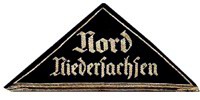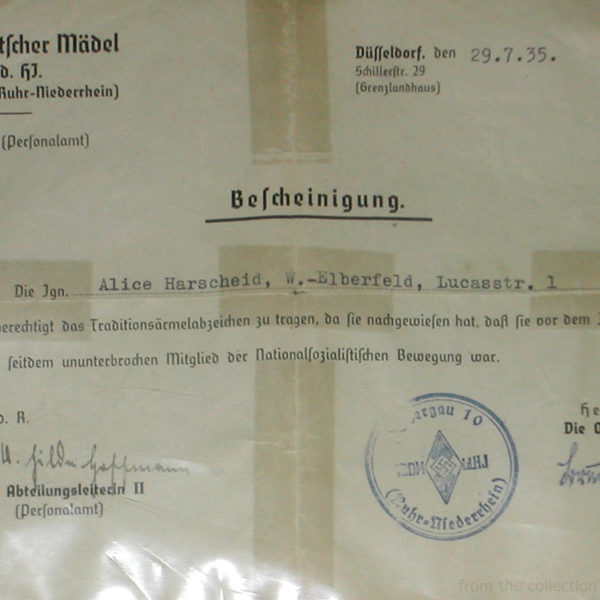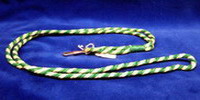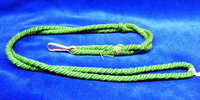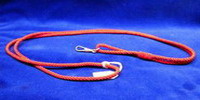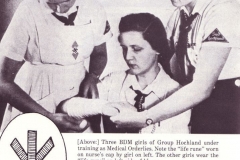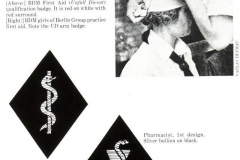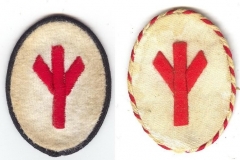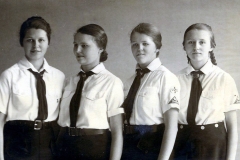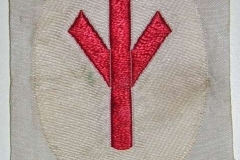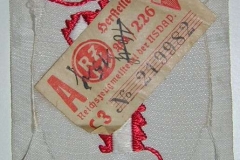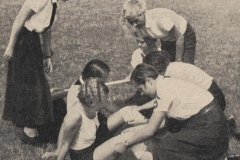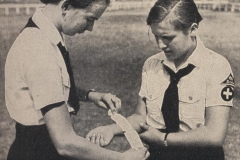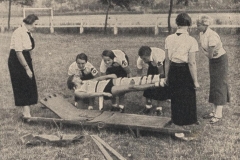Membership Insignia
 All girls of the League of German Girls wore the Hitler Youth insignia seen on the right – a lozenge shaped insignia in red and white with a black swastika in the center – on their uniforms.
All girls of the League of German Girls wore the Hitler Youth insignia seen on the right – a lozenge shaped insignia in red and white with a black swastika in the center – on their uniforms.
The insignia was worn either as a sew-on made from machine-woven cloth, shown on the right, or as an enamel pin.
The sew-on variant was worn on the sleeve of the brown Kletterjacke, and on most sports clothing such as the white sports shirt where it was worn centered on the chest, the Belief and Beauty gymnastics dress, or specialized sporting outfits such as field hockey or ice skating dresses where it was most commonly worn on the lower left chest. Some photos showing it being worn on bathing caps also exist.
The pin-on variant was worn on or above the left chest pocket on the white short-sleeved or long-sleeved blouse, and the Kletterjacke. When worn on the leaders’ uniform tunic that was introduced at the end of the 1930s, the pin would be worn below the embroidered eagle rank insignia on the left chest. Some photos also exist of girls wearing their pin on the lapel of their climbing jacket or on their neckerchief. As this is only seen in close-up studio portraits, it is very likely that it was done simply to include the official insignia of the Hitler Youth when it would not otherwise have been visible in the photo.
Leaders and long-time members who had distinguished themselves in their service could also be awarded the gold-bordered Hitler Youth pin. This award was also given to members of the male Hitler Youth and people from other organizations who had distinguished themselves in working with the youth, including foreign personnel such as Pilar Primo de Rivera, the leader of the Spanish Falange youth who had close ties with the League of German Girls.
Gaudreiecke
In addition the official emblem of the Hitler Youth, girls also wore a cloth insignia called the Gaudreieck, which translates to regional triangle. This was a machine-woven black fabric insignia in the shape of a triangle that bore the name of the wearer’s region and district in the old “gothic” style German script. For the League of German Girls, the triangle was black with white letters, and for the boys in the male Hitler Youth, the triangle was black with yellow lettering. The triangles were introduced for the male youth in 1933, and for the female youth in April 1934, and prior to that date, no insignia were worn on the uniforms.
The Gaudreieck was worn on the upper left sleeve of the white short-sleeved or long-sleeved blouse, as well as on the brown Kletterjacke or the dark blue wool ski jacket. In a few instances, it can also be seen worn on bathing suits and some sports clothing, however, this is relatively uncommon.
The Gaudreiecke worn by most members of the League of German Girls bore the name of the Obergebiet, or region, as well as the name of the Gau, or district, a girl was from. Therefore, readers should not mistake the triangle “Ost Berlin” to mean the East of Berlin, but rather, to mean region East, district Berlin. This can be confusing as districts changed over the years and from 1943 on, Berlin was part of region North, and a Nord Berlin triangle existed (albeit briefly).
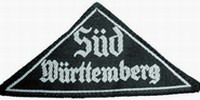
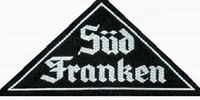
Seen above are an original triangle for Sued Wuerttemberg, and a reproduction triangle for Sued Franken. While BDM insignia are not being widely reproduced, reproduction triangles are becoming more common. Known reproductions are Sued Franken, Sued Schwaben, and West Westmark. The Sued Schwaben one is most commonly sold as “original” and with an RZM tag attached to the back. The Sued Schwaben triangle was only used from 1943 onward, after the reorganization of the Obergebiete.

Gau triangles also existed for League of German Girls units outside of the German Reich, such as the one from the Netherlands pictured above, which was contributed to the website by German militaria dealer Helmut Weitze of www.weitze.net. The male Hitler Youth, as well as the female League of German Girls had a number of formations in foreign countries that consisted of German boys and girls living abroad. Some of the foreign locations included Turkey, Singapore, and Japan.
Special Gaudreiecke
A special triangle existed for girls who were absolving their Landjahr service. It consisted of a green triangle with the word “Landjahr” in white letters, as seen in the photo below.
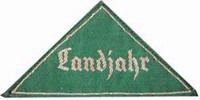 Furthermore, until leaders’ uniforms were introduced at the end of the 1930s, members of the Reichsjugendfuehrung, the national youth leadership staff, wore a black triangle bearing the letters “RJF” in white, and members of the RJF staff wore a triangles bearing the letters “RJF Stab”. Those are two versions that are sometimes seen in photographs taken between 1935 and 1938 worn by higher leaders.
Furthermore, until leaders’ uniforms were introduced at the end of the 1930s, members of the Reichsjugendfuehrung, the national youth leadership staff, wore a black triangle bearing the letters “RJF” in white, and members of the RJF staff wore a triangles bearing the letters “RJF Stab”. Those are two versions that are sometimes seen in photographs taken between 1935 and 1938 worn by higher leaders.
Additionally, a so-called Traditionsdreieck, or traditions triangle, existed. This was an award similar to the “old fighters chevron” of Nazi military and paramilitary organizations and denoted long-time membership in the organization. David Littlejohn writes in his book “The Hitler Youth” that it was awarded group-wide to groups that had been in existence prior to 1933. However, this information is wrong based on some documents I have found awarding the traditions triangle to individual members who had been in the BDM since 1933 and “without a break ever since”. You can see one of those documents below, from the collection of Wayne Armuth.
Furthermore, “Aufbau und Abzeichen der Hitlerjugend”, a period source published by the National Youth Leadership Staff, states the following: “The traditions triangle was worn by all members of the Hitler Youth and BDM who, prior to 30. January 1933 (or in the case of groups outside the Reich, a date prior to their respective regions’ return to the German Reich), been a member of the Hitler Youth, BDM, Nazi party or any of their groups. This insignia consisted of a gold (for members of the BDM, silver) tress that was attached at the lower edge of the triangle.”
You may view the document below by clicking on it. Copyright for this document belongs to Wayne Armuth, who has allowed us to use it on our website.
Cufftitles
In addition to the sleeve triangles, the League of German Girls knew several different kinds of cufftitles.
Prior to the introduction of the new leader uniforms in 1939, an “issue” brown greatcoat existed. The unusual feature about the greatcoat was that it was not worn with either the Hitler Youth insignia or the Gaudreieck sewn to it, but rather, with a cufftitle. For girls of the Jungmaedel, the cufftitle was brown bearing the name of the Obergau in white letters, and for girls of the BDM the cufftitle was dark blue with white lettering. The cufftitle was to be sewn on at “three-fingers width above the cuff of the sleeve”. Of an interesting note should be that in all my research, I have yet to see a photo of the brown greatcoat being worn, although drawings of the same exist in a number of period sources.
A lot of uniform changes were made for BDM leaders in 1939 when the dark blue leaders’ uniform was introduced along with new rank insignia and a cufftitle in lieu of the Gaudreieck. The cufftitles worn on the leader uniforms were black in color and embroidered in silver or gold bullion according to rank. Leaders who had been members prior to 1933 and without break since were authorized to wear the silver traditions bar at the bottom of their cufftitle, which replaced the traditions bar worn on the Gaudreieck previously. A white cufftitle with silver bullion embroidery was worn on the summer tunics.
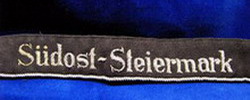

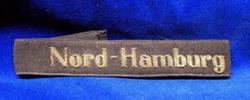
The leadership uniform cufftitles pictured above were contributed to the website by German militaria dealer Helmut Weitze of www.weitze.net. The top image shows a black cufftitle for the winter uniform, embroidered in gold for higher leaders. The two bottom ones are from the same girl and show cufftitles for the Styria region of Austria and show the white version for the summer uniform as well as the black version for the winter uniform, embroidered in silver bullion. Of note is also the silver traditions bar at the bottom of each of those.
Two other cufftitles that are sometimes seen in photos are for the Landdienst der HJ and the BDM-Osteinsatz. The cufftitle for the Landdienst der Hitlerjugend (Country Service of the Hitler Youth) was black with white lettering and was worn by both males and females during their country service year. It was worn on the lower left sleeve of the jacket, as seen in the photo below.
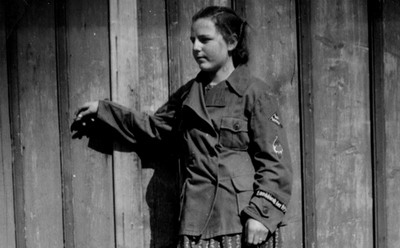
After 1940, the BDM Osteinsatz (BDM Work in the East) was introduced and along with it another cufftitle, as seen below. Even though this cufftitle looks like its color is black with white lettering, the actual cufftitle is a dark chocolate brown. It should be noted that Osteinsatz cufftitles were always a dark brown color and did not come in black, blue, or any other colors.

Leadership Lanyards
Similar to the male Hitler Youth, the League of German Girls used colored lanyards as an indication of both grade and function. Until the League of German Girls introduced special leaders’ uniforms in 1938, and with them, special leaders’ insignia, the lanyard served as the sole indication of rank in both the BDM and the Jungmaedel.
Two styles of leadership lanyards existed: the short one seen in the photo below, and a long one. The long lanyard was worn around the neck underneath the neckerchief and looped through the leather slide at the front. The short lanyard was worn either looped through the leather knot while wearing the white blouse without a jacket, or from the second button of the Kletterjacke. In both cases, the end with the silver clasp was tucked into the left chest pocket. It is often assumed that the lanyard served to hold a whistle, however, there seem to be neither photographic evidence nor personal accounts to support this claim.
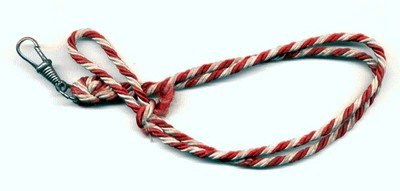
The red-and-white lanyard seen above is for the rank of a Maedelschaftsfuehrerin, but these colors were not adopted for use until 1936. Prior to that date, the rank first used the state colors, and later the colors of the region. No changes were made to the colors used for other ranks within the League of German Girls. The rank lanyards were as follows – from lowest to highest rank:
JM- or Maedelschaftsfuehrerin – red and white
JM- or Maedelscharfuehrerin – green
JM- or Maedelgruppenfuehrerin – green and white
JM- or Maedelhauptgruppenfuehrerin – blue
JM- or Maedelringfuehrerin – white
JM- or Untergaufuehrerin – red
(called Bannmaedelfuehrerin after 1942)
JM- or Gaufuehrerin – red and black
(called Hauptmaedelfuehrerin after 1942)
Obergaufuehrerin – black
(called Gebietsmaedelfuehrerin after 1942)
Gauverbandsfuehrerin – black and silver
(this rank was discontinued in 1939/1940)
The leadership lanyards pictured above were contributed to the website by German militaria dealer Helmut Weitze of www.weitze.net. From top left to bottom right they are: Gaufuehrerin, Untergaufuehrerin, Gruppenfuehrerin and Scharfuehrerin.
Leaders’ Insignia
In 1939, a new uniform was introduced for regional and national leaders within the League of German Girls, and along with the new uniforms came new rank insignia for leaders. These new rank insignia took the form of a silver, and for higher ranks, gold bullion embroidered open-winged eagle on a black (white, on the summer tunic) shield with various types of borders to indicate grade. They were worn on the left chest of the tunic.
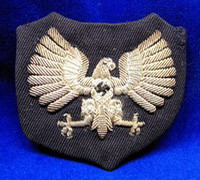
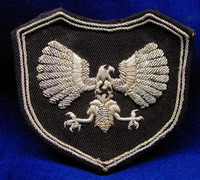

The insignia above were contributed to the website by German militaria dealer Helmut Weitze of www.weitze.net. The page below shows the different leaders’ ranks. The source is David Littlejohn, “The Hitler Youth”, page 186, and all copyright remains with Mr. Littlejohn and his publisher, Agincourt. Click on the image to see the full version which, unfortunately, didn’t fit into the layout in its original size.
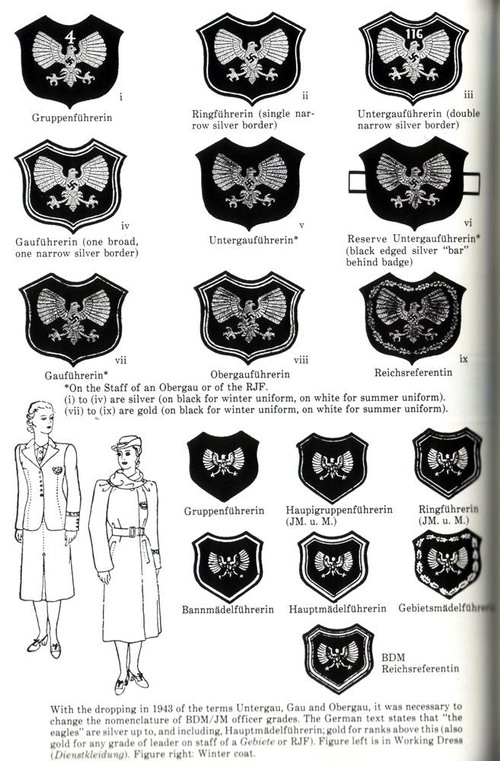
Proficiency Clasps
The proficiency awards were introduced for both the League of German Girls and the Jungmaedel on April 28, 1934. This achievement badge – Leistungsabzeichen in German – was in the shape of the initials “BDM” inside a rectangular frame with a plain red ribbon background for the Jungmaedel and red-white-red for the League of German Girls. Originally, both were in a silver frame with silver letters, but in 1935 a bronze award was added for the League of German Girls. After that, the letters and frame denoted the grade of the award – bronze for the Leistungsabzeichen I or silver for the Leistungsabzeichen II.
The same letters and frame in silver on a solid red background were awarded as the achievement badge of the Jungmaedel until 1940, at which point a special Jungmaedel award was created. This new award, seen in the photo below, took the shape of the letters JM on a solid red background. After the introduction of this award, the frame with the letters BDM on a red-white-red background was only used for the BDM award. The Jungmaedel award only came in one grade.


In order to earn the proficiency clasp, the tests had to be completed within the span of a year, and covered nursing, first aid, political knowledge, and physical and athletic exercises. Members of the Jungmaedel were not allowed to try for their award until their 12th birthday, even though the age they became eligible to join the organization was 10.
More than 115,000 awards of the BDM clasp and 58,000 awards of the JM clasp had been made by 1943. Issued examples are usually numbered on the reverse, but some also have a letter A or B on the back. There is some confusion as to what the letters stood for. Some assume that it was an age grading (Littlejohn, “The Hitler Youth”) while others believe that B marked pieces served as replacements of the original awards.
In 1942, an additional proficiency badge for leaders was introduced, but my sources give neither a photo, nor a description of this badge. I have seen two examples of a badge bearing the letters BDM with a green and red ribbon background which might be the leaders’ proficiency badge. If anyone has any more information on the leaders proficiency badge, please email it to me!
Trade Badges
Unlike the male Hitler Youth, which had a very large variety of trade badges a boy could earn, the League of German Girls only had medical trade badges. Like the male Hitler Youth, the League of German Girls originally used the internationally recognized Aesculapius snake-and-staff emblem as its medical symbol. This insignia was worn on the left lower sleeve of the jacket. On the white blouse, the insignia was either worn on the left sleeve below the Gau triangle (if there was space) or on the right chest pocket.
Some groups of medical service girls also wore a Red Cross patch seen in some of the photos below that were taken from an article in “The German Girl” magazine, the BDM’s own publication. I am assuming that this patch was red or black felt with an embroidered white cross, but do not have any color images of this patch.
In September of 1938, the medical insignia were changed for both the male and female Hitler Youth and the new insignia showed the so-called Life Rune. The insignia were made embroidered on a felt background, or BeVo machine-woven.
In addition, BDM doctors, dentists, and pharmacists also changed their insignia in 1938.
Doctors: silver life rune on grayish-blue oval
Dentists: silver life rune on grayish-blue rectangle
Pharmacists: silver life rune on grayish-blue inverted triangle
Gesundheitsdienst-Maedel (health service girls) wore:
GD Maedel: red life rune on white oval with red and white surround
GD Maedel (Gruppe): red life rune on white oval with green and white surround
GD Maedel (Untergau): red life rune on white oval with red surround
GD Maedel (Obergau): red life rune on white oval with black surround
GD Maedel (Reichsjugendfuehrung): red life rune on white oval with gold surround
For images of the insignia, please view the pages below.
The first two images are from the book “The Hitler Youth” by David Littlejohn. The third and fourth are from the personal collection of Rik at www.panzergirl.com. The BeVo insignia is from the webmaster’s collection. The remaining images are from a period publication. All rights remain with the image’s owners.



